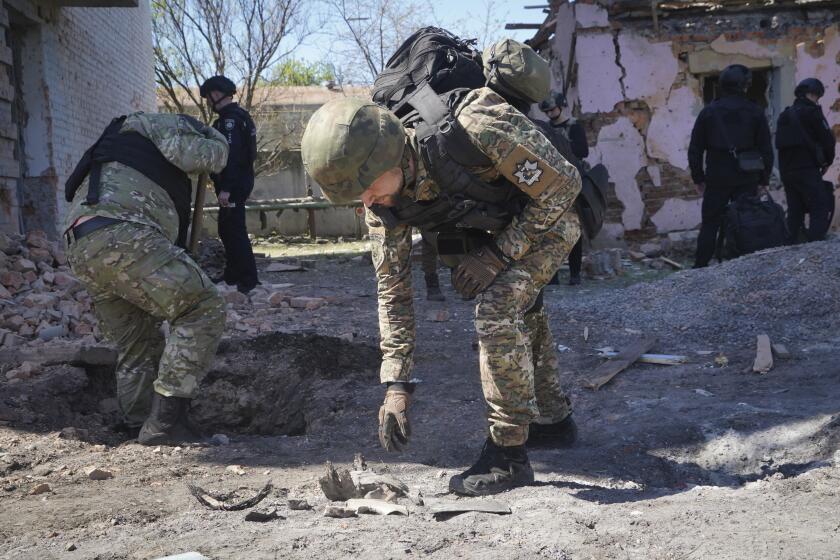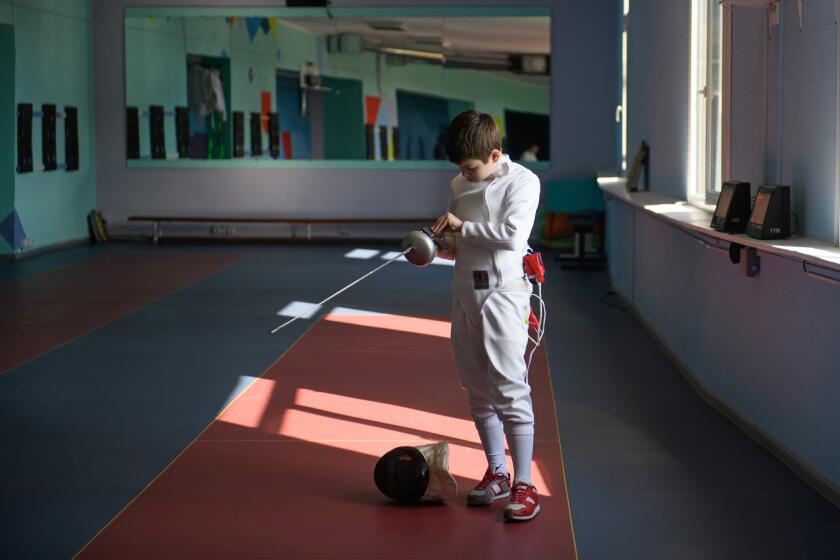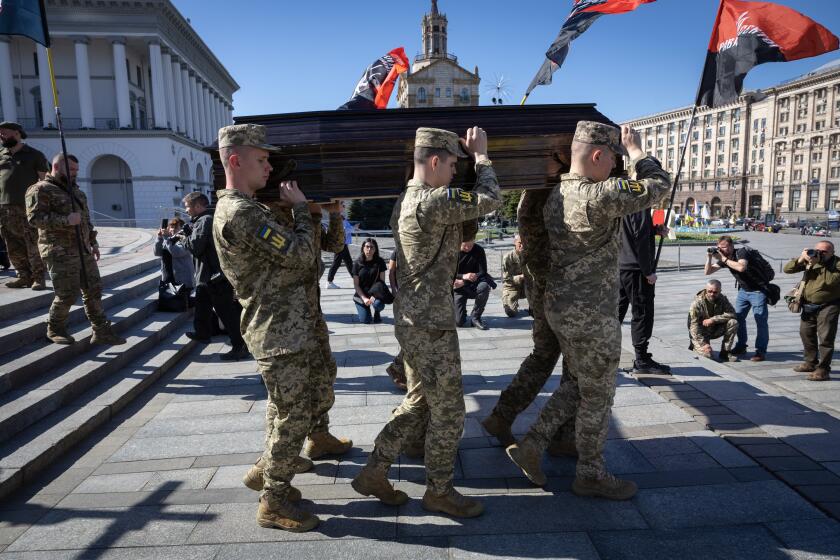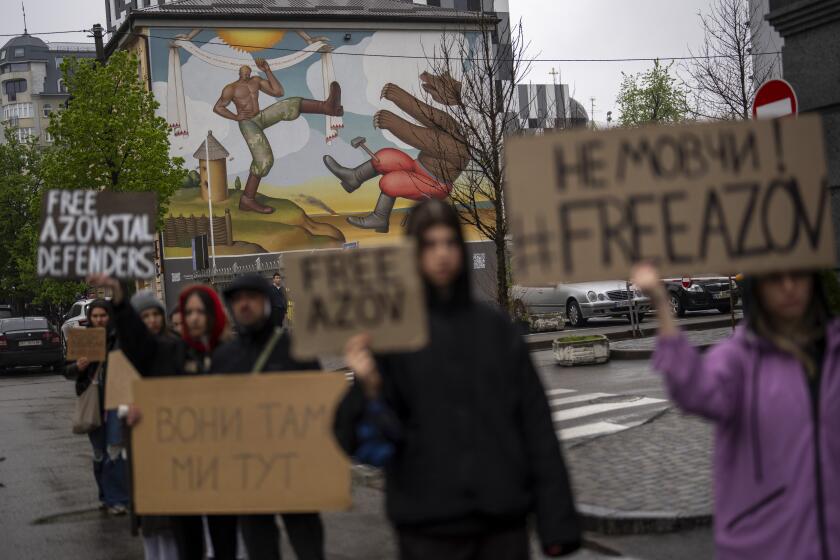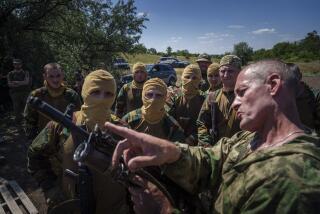Ukraine’s divisive mobilization law comes into force as new Russian push strains front-line troops
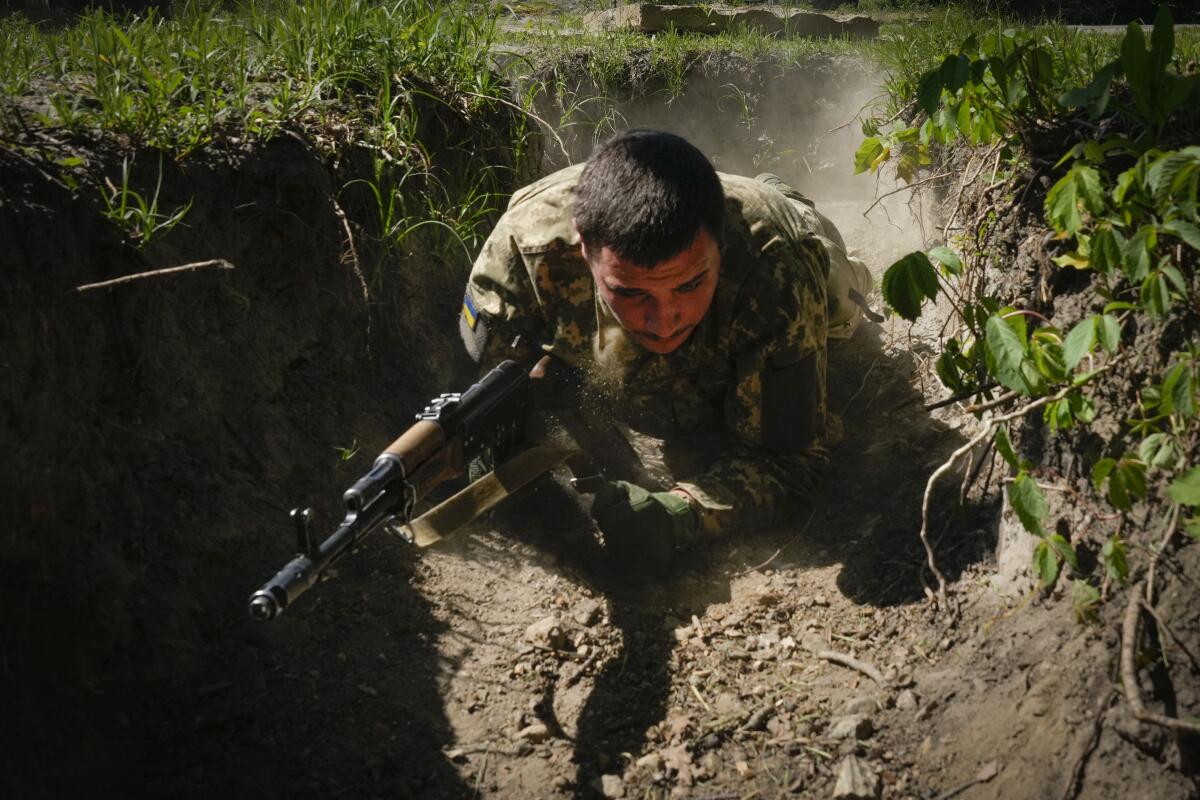
- Share via
KYIV, Ukraine — A divisive mobilization law in Ukraine came into force on Saturday, as Kyiv struggles to boost troop numbers amid a new Russia offensive that some fear could close in on Ukraine’s second-largest city.
The legislation, which was watered down from its original draft, will make it easier to identify every conscript in the country. It also provides incentives to soldiers, such as cash bonuses or money toward buying a house or car, that some analysts say Ukraine cannot afford.
Lawmakers dragged their feet for months and passed the law only in mid-April, a week after Ukraine lowered the age for men who can be drafted from 27 to 25. The measures reflect the growing strain that more than two years of war with Russia has had on Ukraine’s forces, who are trying to hold the front lines in fighting that has sapped the country’s ranks and stores of weapons and ammunition.
Ukrainian President Volodymyr Zelensky signed two other laws Friday, allowing prisoners to join the army and increasing fines for draft dodgers fivefold. Russia enlisted its prisoners early on in the war, and personnel shortages compelled Ukraine to adopt the new, controversial measures.
Concerns about the law
Oleksii, 68, who runs a car repair shop in Kyiv, worries his business will have to shut down as he expects 70% of his workers will be mobilized. He asked that only his first name be used to allow him to speak freely.
Ukraine is trying to determine if Russia’s ground attack in Kharkiv is opening a new war front — or meant to divert overstretched Ukrainian troops?
“With the new law, people will be mobilized and we will have to shut down and stop paying taxes,” Oleksii said Saturday. He said it’s very difficult to replace workers because of their specialized skills. Most of them are already in the armed forces, he said, adding that the law is “unfair” and “unclear.”
Viktor Kaminsky, the head of a municipal service department in Kyiv that fits households with heating and repairs utilities in public buildings, said he will struggle to replace mobilized staff and meet demand, even though the law allows him to retain half of workers deemed fit for service.
Kaminsky said 60 of the 220 people working in his department will be eligible to be called up. “If they take 30 people from what we have, the problem is we don’t have anyone to replace them,” he said.
“There are pros and cons to this law,” Kaminsky said. “It’s hard to avoid the mobilization process now, compared to before when people were trying to get around it.”
Kharkiv, Ukraine’s second-largest city, is facing intense Russian airstrikes, but its residents are defiant. “We can stand up, no matter what they do,” one said.
Meanwhile, Oleksii Tarasenko, a deputy commander of a Ukrainian assault battalion, told AP that his men felt “awful” about the law’s failure to address the issue of demobilization. Although many troops have been fighting since the war’s early days, it remains unclear when they might be relieved.
“It feels like a cruel injustice towards people who have been fighting for two years, and of course, it has a highly negative effect on the psychological state of soldiers and their families,” Tarasenko said.
Tarasenko said that despite their weariness, his comrades know they are needed. “We already see how many people are lacking, especially professional troops in the units. And simply allowing such professional people who have been through a lot to demobilize would be wrong,” he said.
Ukrainian forces under strain
Ukraine has struggled for months to replenish depleted forces, as Russian troops push ahead with a ground offensive that opened a new front in the northeast. Moscow launched the new push knowing that Ukraine suffered personnel shortages and that its forces have been spread thin in the northeastern Kharkiv region.
Moscow’s forces have pummeled Kharkiv with strikes in recent weeks, hitting civilian and energy infrastructure and prompting angry accusations from Zelensky that the Russian leadership sought to reduce the city to rubble. Mayor Ihor Terekhov said five people were injured Saturday in a Russian airstrike that hit a residential area. On Friday, he said, Russian guided bombs killed at least three residents and injured 28 others .
Moscow denies deliberately targeting civilians, but thousands have died or suffered injuries in the more than 27 months of fighting.
Kharkiv regional Gov. Ihor Syniehubov on Saturday said that nearly 10,000 civilians had to be evacuated from front-line areas near the Russian border. Only 100 residents remain in Vovchansk, the border town at the center of Moscow’s grinding push that’s now largely in ruins. The town had a pre-war population of more than 17,400.
The U.S. last week announced a new $400-million package of military aid for Ukraine, and President Biden has promised that he would rush badly needed weaponry to the country to help it stave off Russian advances. Still, only small batches of U.S. military aid have started to trickle into the front line, according to Ukrainian military commanders, who said it will take at least two months before supplies meet Kyiv’s needs to hold the line.
Could Ukraine lose the war? Once nearly taboo, the question hovers in Kyiv, but Ukrainians believe they must fight for their lives against Putin’s troops.
Volunteers and runaways
Rusyn is the head of recruitment for the 3rd Assault Brigade, one of the most popular among Ukrainian volunteers. He told AP that he saw a 15% increase in men joining the brigade, which fights in eastern Ukraine, in the last months. Most recruits are between 23 and 25, he said. Speaking at a training session in Kyiv, Rusyn and his recruits asked to be identified by their call signs only, citing security concerns.
“There is no alternative [to mobilization],” said Rohas, a 26-year-old recruit. “One way or another, I believe that most men will end up in the ranks of the armed forces and by joining as a volunteer, you still get some preferences.”
“Those who are afraid of being mobilized are not the ones hostage to this situation, it’s those [soldiers] who are standing in formations of three where there should be 10,” Rohas said. “Those guys are hostages to this situation and they should be replaced, so that’s why we are here.”
Amid worsening Ukraine war outlook, an infusion of American military aid is seen as crucial in the fight against Russian invaders. Will it be enough?
Many Ukrainians have fled the country to avoid the draft since Russia’s all-out invasion in February 2022.
Ukraine’s Supreme Court last month said that 930 people had been convicted of avoiding mobilization in 2023, a fivefold increase from the previous year.
About 768,000 Ukrainian men aged 18 to 64 had been granted temporary protection in European Union countries as of last November, according to data from the bloc’s statistical agency, Eurostat.
Kyiv has barred men under 60 from leaving the country since the start of the war, but some are exempt, including those who are disabled or have three or more dependents. The Eurostat data do not specify how many of the men who have qualified for protection belong to these categories, nor how many others reached the EU from Ukraine’s Russian-occupied territories in the east and south.
Unable to cross the border legally, some Ukrainian men risk death trying to swim across a river that separates Ukraine from Romania and Hungary.
Late on Friday, Ukraine’s border service said that at least 30 people have died trying to cross the Tisza River since the full-scale invasion.
Kullab reported from Kyiv, Kozlowska from London for the Associated Press. AP writer Alex Babenko in Kyiv contributed to this report.
More to Read
Sign up for Essential California
The most important California stories and recommendations in your inbox every morning.
You may occasionally receive promotional content from the Los Angeles Times.
